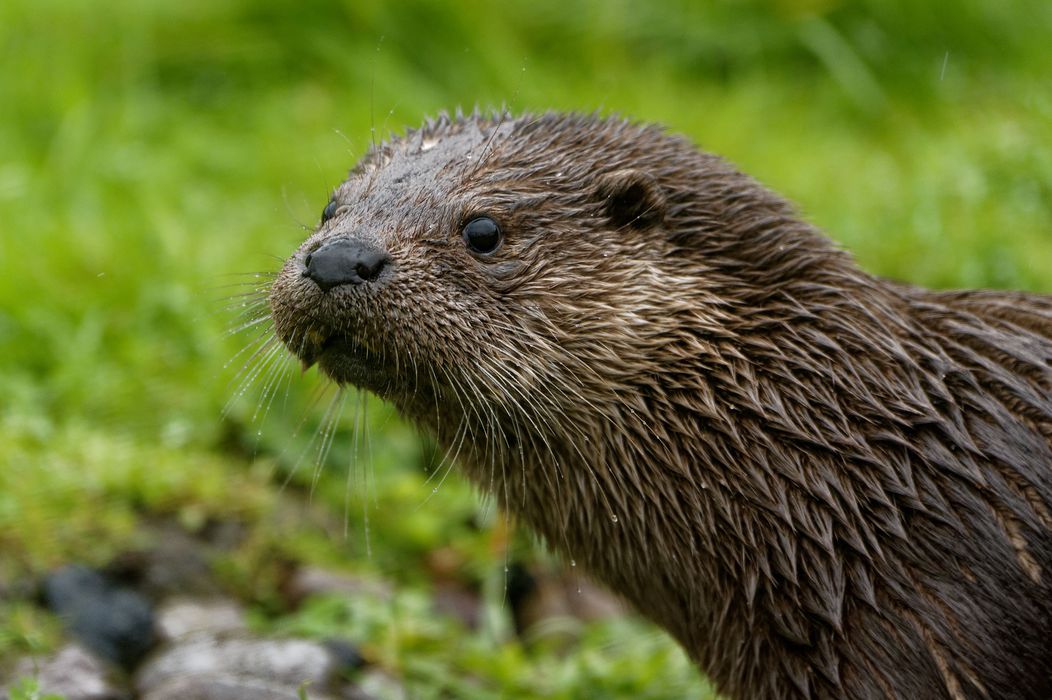Otter Hunting – why the Hunting Act must be strengthened
By Paul Tillsley
Posted 30th July 2025
The League Against Cruel Sport's Head of Conservation shares the history of otter hunting and the League’s continued efforts to protect these animals from hunters.
Otter hunting has been banned in England and Wales since 1978 (two years later in Scotland), but some hunts continue to target otters throughout the summer months.
Records of otters being killed for their pelts or as pests go back to medieval times, but otter hunting with dogs really came to the fore in the eighteenth century and increased in popularity through the 1800s.
In 1844, the famous painter Edwin Landseer was commissioned by the 4th Earl of Aberdeen (later to become Prime Minister) to paint the grotesque image of a huntsman proudly goading his hounds by waving an otter speared on a barbed lance above their heads. The painting immediately drew criticism, and the ensuing dissent against the vile activity of otter hunting eventually played an important part in the formation of the League Against Cruel Sports in 1925.
The Humanitarian League was the first organisation to actively campaign against otter hunting. In 1901, it produced a pamphlet entitled British Blood Sports – Let us go out and kill something, and in 1911 it published a booklet called The Hunted Otter that highlighted the cruelty of otter hunting, the horrendous number of otters killed by hunts, and also the involvement of women and children in the brutal pastime.
In 1905, the RSPCA brought a case against the master of the Cheriton Otterhounds for cruelty to cats. The otter hunters involved had been using cats in a specially constructed wooden tunnel to train their young terriers to bolt – or flush – otters from their habitat. The horrifying case drew media attention and the master’s only defence was he couldn’t find any badgers to use.
The following year a proposal was agreed at the RSPCA’s annual meeting to put forward a bill to parliament to ban otter hunting, but it was later dropped due to pressure from the hunting lobby.
After the Humanitarian League was dissolved in 1919, Henry Amos and Ernest Bell went on to form the League Against Cruel Sports – then called the League for the Prohibition of Cruel Sports - and the fight against otter hunting continued.
The first recorded protest at an otter hunt was organised by the League in 1931 against the Buckinghamshire Otterhounds, and more protests were organised across the country by us throughout the 1930s until war intervened.
The peace was not to last. In just five years, between 1958 and 1963, 11 hunts in England and Wales reportedly killed a staggering 1,065 otters between them.
From the 1950s through to the 1970s persistent pesticides, such as DDT and Dieldrin, leaching into watercourses caused a rapid decline in otter numbers. Otter hunters were some of the first to notice the decline, but they continued hunting and killing otters right up to the end of the 1977 season, when they knew an Act to protect otters was imminent.
At this point, some otter hunts disbanded, but others merely rebranded to hunt the American mink. Mink had been brought to the UK in the 1920s to satisfy the fashion for mink fur, but escaped into the countryside and started breeding, and by the end of the 1970s they were present in waterways throughout the country. Mink were always seen as an inferior quarry to otters, and otter hunters held on to the hope that otter hunting would return one day.
When the Hunting Act finally came into force in 2005, mink hunting was also banned, and again some hunts faded away, but others rebranded once again. This time hunts claimed they were hunting animals not covered by the act, such as rats, just exercising their dogs, or even more ridiculously carrying out surveys.
In the meantime, otter numbers had recovered, and they had returned to most of their previous haunts around the waterways of Britain. The lure of hunting otters was too much for some of the remaining otter hunters and they slipped back into their old ways, hoping no one would notice.
Today, around a dozen hunts still spend the summer tramping around the waterways of the UK looking for otters and other animals to hunt. They are often accompanied by men with terriers and spades to evict any animal that ‘goes to ground’.
Some staff and followers even carry otter poles, with notches that proudly display the number of animals they have killed.
It is time the Hunting Act was strengthened to end this activity for ever.

Photo credit: Colin Seddon and the UK Wild Otter Trust